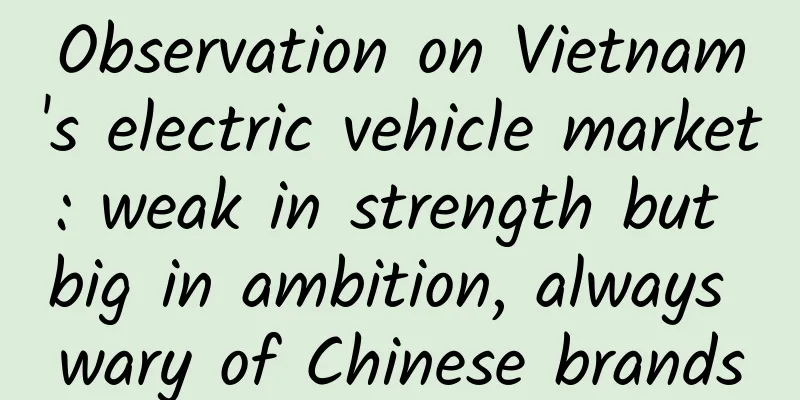Observation on Vietnam's electric vehicle market: weak in strength but big in ambition, always wary of Chinese brands

|
In recent years, have you often heard that "Vietnam will replace China as the world's factory"? This is of course an exaggeration. In the foreseeable future, Vietnam's economic counterpart should be China's Guangxi Province. But Vietnam is indeed a "little strong" in Southeast Asia, with good development potential in many areas. Taking the new energy vehicle market as an example, Vietnam cannot be called a major player in terms of sales volume, core technology, and infrastructure. However, new energy vehicles are the future after all, and Vietnam is ambitious. In 2023, Vietnam's domestic new car sales were 369,439 units, with an average monthly sales of just over 30,000 units, which is roughly the same level as China's Ideal Auto; a year-on-year decline of 27.4%, proving that Vietnam's automobile industry has experienced setbacks. In terms of new energy vehicles, Vietnam's sales of new energy vehicles in 2023 will be around 18,000 units, which is comparable to the strength of some leading brands among China's new car-making forces, and its impact on the entire automobile market is relatively small. In the words of BYD Vietnam CEO Wu Mingli, the development of Vietnam's electric vehicle market is still in its infancy, and the number of electric vehicle brands on the market is limited. However, Vietnam's new energy vehicle market is developing very rapidly. In the first quarter of 2024, Vietnam's electric vehicle sales increased by more than 400% year-on-year, accounting for about 17% of the total electric vehicle sales in Southeast Asia during the same period. In other words, although the overall sales volume is not large, Vietnam is also on the table of the "Southeast Asian electric vehicle market". Interestingly, a relatively competitive domestic brand, VinFast, has appeared in the Vietnamese new energy vehicle market. BYD is undoubtedly the leader in the current Southeast Asian electric vehicle market, with a market share of 47%, but the second largest company after BYD is the Vietnamese electric vehicle company VinFast. This is a rather magical company. Its founder, Vietnam's richest man Pham Nhat Vuong, started his business by selling instant noodles in Ukraine. Its main asset is Vingroup, whose annual revenue is equivalent to 2% of Vietnam's annual GDP. VinFast is the company's electric vehicle division. VinFast was founded in 2017, launched its first fuel vehicle in 2019, delivered its first electric vehicle to Vietnamese customers at the end of 2021, announced the discontinuation of fuel vehicles in July 2022, became the only pure electric vehicle brand in Vietnam, and entered the US market in September 2022. In the first quarter of 2024, VinFast sold 8,200 electric vehicles in Vietnam, a 385% increase from 1,689 in the same period of 2023, becoming a major force in the electric vehicle market in Vietnam and even the entire Southeast Asia. VinFast itself does not possess any core technology. Its batteries come from manufacturers such as LG, its electric drives mainly come from suppliers such as Bosch, its vehicle design is mainly the responsibility of Italy's Isotta, and its software and electronic systems mainly come from companies such as Mobileye. Although it does not have core technology, VinFast can still produce an electric car with good performance and has been recognized by many users. This also proves from the side that Vietnam has a certain foundation in the field of electric vehicles and also has good industry development prospects. Vietnam is a country with a very high population density, with a total population of over 100 million. At the same time, its natural resources are relatively scarce and it is highly dependent on foreign supplies of oil. Therefore, Vietnam is relatively active in developing new energy vehicles. According to Vietnam's domestic policies, the registration fees for domestically produced and assembled cars will continue to be reduced between August 1, 2024 and January 31, 2025, with the aim of stimulating consumer purchasing enthusiasm and promoting the development of electric vehicles. When it comes to charging infrastructure, Vietnam is in the same situation: it is in its infancy, but developing very rapidly. At present, Vietnam's charging piles are mainly composed of three parts. One is the charging stations built by foreign brands, such as Porsche, Audi, Mercedes-Benz, etc., but these charging piles are installed in 4S stores or factories; the second is the own-brand charging piles developed by Vietnam Electricity Group, a Vietnamese state-owned enterprise, with a cumulative number of 850 units worldwide; the other is VinFast, which is currently in a leading position in the construction of charging piles and has built 150,000 electric vehicle or motorcycle charging piles across the country. But these are obviously not enough. In early September, the Vietnamese government announced that it would allow electric vehicle charging stations to be operated in a franchised manner and selected V-GREEN as the first pilot enterprise. With such a policy, Vietnam's charging infrastructure will usher in a period of rapid expansion. In addition, Vietnam Electricity Group has also begun to make efforts. According to the plan, the company will invest more than 102 billion VND in the construction of power infrastructure in 2024 to provide infrastructure support for the development of electric vehicles. It is worth mentioning that Vietnam is quite wary of China, which is quite obvious in the development of electric vehicles. So far, BYD, Lynk & Co, GAC, Geely, Zeekr, Chery and other manufacturers have plans to build factories in Vietnam, but for various reasons, Chinese manufacturers have encountered a lot of trouble in Vietnam. Vietnam is the Southeast Asian country closest to China, but BYD did not enter the Vietnamese market until July this year, and the news that BYD would build a factory in Vietnam, which was previously reported by the media, has not been followed up yet. Not only that, the progress of manufacturers such as GAC and Chery in Vietnam is also relatively slow. Even Wuling, which has swept the low-end car market, has not been able to gain a foothold in Vietnam. Vietnam and China are adjacent to each other, which is a geographical advantage. However, Chinese manufacturers have a very low presence in the Vietnamese electric vehicle market. At the same time, Chinese manufacturers prefer Thailand and Indonesia when building factories overseas, rather than Vietnam, which is close at hand. Vietnam also prefers to look for far-flung manufacturers such as LG rather than China's CATL when choosing suppliers. This special phenomenon may bring some new variables to Vietnam's electric vehicle market in the future. No matter what, Vietnam's new energy vehicle industry will continue to move forward; but can Vietnam, which is always wary of Chinese brands, really develop its own electric vehicle industry independently? As a winner of Toutiao's Qingyun Plan and Baijiahao's Bai+ Plan, the 2019 Baidu Digital Author of the Year, the Baijiahao's Most Popular Author in the Technology Field, the 2019 Sogou Technology and Culture Author, and the 2021 Baijiahao Quarterly Influential Creator, he has won many awards, including the 2013 Sohu Best Industry Media Person, the 2015 China New Media Entrepreneurship Competition Beijing Third Place, the 2015 Guangmang Experience Award, the 2015 China New Media Entrepreneurship Competition Finals Third Place, and the 2018 Baidu Dynamic Annual Powerful Celebrity. |
<<: What to do with Samsung's recalled Note 7? Dismantle and extract precious metals
>>: Huawei nova hands-on review: how the fashionable phone interprets youthful vitality
Recommend
New App Promotion Techniques: Video Promotion Makes Your App Popular Overnight
Everyone on the Internet is familiar with Chai Ji...
Analysis of APP promotion and new customer acquisition activities!
The author introduced the specific operations of ...
The J-20 is equipped with a Chinese "heart"! "The aviation engine cannot be obtained by asking for it or begging for it!"
At the 13th China Airshow last year The J-20 equi...
Analysis of Xiaohongshu's competitive products
From sharing overseas shopping to establishing it...
2021 Postgraduate Entrance Examination English Vocabulary Solution [Postgraduate Entrance Examination] PDF electronic version Baidu Cloud Download
This book selects valid vocabulary from the Engli...
Xiaohongshu is back on the shelves, how to carry out promotion?
After 77 days since the Xiaohongshu APP was taken...
It will rain every day in the future... What is the "cold vortex blue" that dominates the Beijing sky?
Review expert: Ye Haiying, deputy director of the...
Is parking and charging difficult? SAIC New Energy provides free services at Hongqiao Hub!
Recently, in response to the parking difficulties...
Hot search! E. coli was detected in ice cream. Does it mean it is contaminated by feces? Can we still eat it safely?
Recently, a media report said that half of the ic...
Xiaopeng Motors is launched in Beijing and Chairman He Xiaopeng becomes the first owner
He Xiaopeng, chairman of Xpeng Motors, drove the ...
How to set up WeChat Tap? How to set the suffix and add text to WeChat Tap?
After the update, WeChat has a "Tap" se...
Baidu promotion invalid clicks, how to avoid invalid clicks?
Friends who are engaged in Baidu bidding promotio...
How to do a good job of user recall? Share 4 tips!
Last year, I was responsible for user recall. Use...
Wuwei Academy Wuwei Teacher Main Line Capture Dragon Fourth Episode
Introduction to the fourth issue of Wuwei Academy...
Can't drink coffee during recovery from COVID-19? Here comes the January scientific rumor list!
1. Do not drink coffee during the recovery period...

![The soul of the Manhattan Project, the most powerful problem solver of the 20th century [Part 1]](/upload/images/67f20df616c8f.webp)







